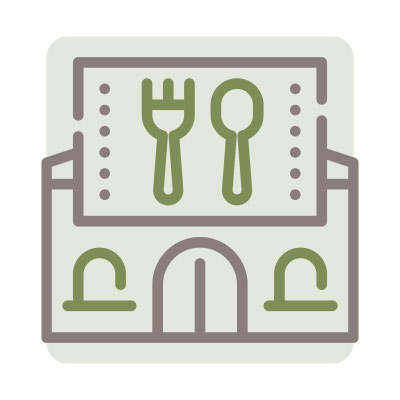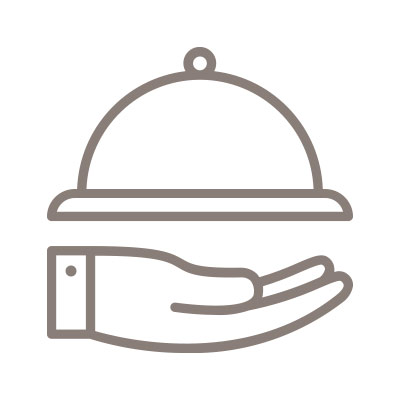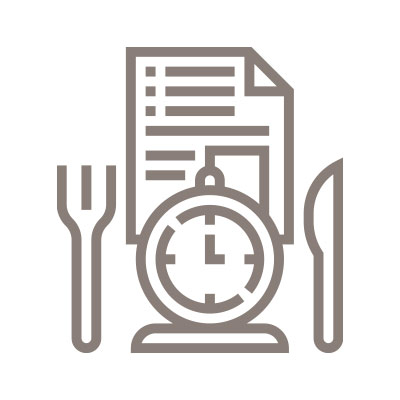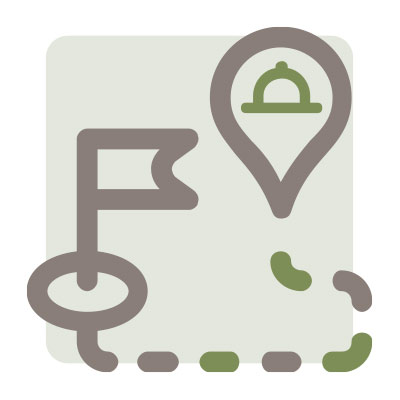It’s more important than ever for your restaurant to develop a successful marketing strategy. Unfortunately, with thousands of choices for restaurants in big cities, word-of-mouth just isn’t enough anymore.
To succeed in marketing, restaurants need to be on social media platforms, optimize their websites for search engines, and have eye-catching designs that lend themselves well to brand recognition. Without all of that and more, your restaurant may struggle to stand out from the competition.

Putting Together a Successful Marketing Strategy for Your Restaurant
If you’re just starting your restaurant or you only have experience working on the backend, you might not know where to start when it comes to marketing. This is often the case with restaurants and other small businesses, as they believe they don’t have the time, money, experience, or resources. However, marketing is a critical element of your success that should not be overlooked. In this guide, we’ll teach you how to create your marketing strategy and put it into action.

Develop Your Brand
Before you can flesh out your marketing strategy, you should first take a look at your restaurant’s brand. Your brand should be cohesive and recognizable. When people see your social media posts or menu design, they should know it’s from your restaurant without having to check.
Without a cohesive brand, your marketing attempts might be messy and incohesive. Branding your restaurant should include coming up with the following:
- Core values
- Mission statement
- General tone
- Professional logo design, color story, unique design elements
By deciding on these elements early, you’ll be able to create necessary brand materials later on easily. Building consistency within your brand materials is important, as it helps to further build brand awareness and recognition. Every single marketing material you produce is a potential touchpoint that will either reinforce or dilute your brand. Materials include social media posts, signs, menus, and more.
Having a clear brand strategy is vital for successful marketing. Without developing a brand strategy, marketing materials and outreach may appear messy, meaningless, and will be much less effective.

Set Objectives and Concrete Goals
It can be easy to become overwhelmed with all the potential marketing projects when you’re first starting out. When creating your marketing strategy, plan out exactly how much time you and your team have available to spend on these projects, and what you want to accomplish each month and each week for the first few months. This is especially important for small businesses and restaurant owners who are famously strapped for time.
It’s essential to set these goals to hold yourself accountable. You should adjust as you go, making notes of goals you were and weren’t able to meet. Take notes on why specific goals were achieved and what stood in the way of others.
A few examples of strong goals to set for your restaurant include:
- An increase in dine-in and takeout sales
- Increase social media following and engagement
- Drive more visitors to your website by improving SEO
- Boost the use of your loyalty program or punch card system
Using these goals, you should be able to work out a good layout for your marketing plan.
You should also think about your top-tier objectives, i.e., why you’re starting a marketing campaign for your restaurant in the first place.
For most people, it’s to find new customers and generate higher revenue. Are you looking to boost name recognition or advertise sales and events? Thinking about these objectives can make it easier to brainstorm content later on down the road.

Create a Budget
Before you start marketing, you’ll want to plan out how much money you can afford to spend on marketing efforts. Your budget should include any employees you plan on hiring for the marketing team and their yearly salaries, as well as whatever amount you’re willing to spend on paid advertising and marketing materials, like software, Google Adwords, and print marketing (flyers, posters, etc.).
To start creating a budget, you should first understand your sales funnel and how a prospective client becomes a customer. Use this information to find out what your weak points are. Is your site not getting enough traffic? Are you not generating enough leads? Are your conversion rates low?
For the typical restaurant, a sales funnel may look like this:
- Generating interest and turning followers into contacts — social media advertising, exterior signage, optimized websites
- Converting that interest into a sale, turning those contacts into paying customers — holding events, sales, and other promotions that help bring interested parties into the restaurant
- Turning regular customers into consistent customers — proving a great experience for customers to keep them coming back again and again
By analyzing this information, you can figure out where you need to improve your marketing strategy and where you’ll need to spend the most time and money.
On top of identifying where your strategy needs improvement (and money), you’ll also need to consider your operational costs and revenue and determine how much money you have available to allocate towards marketing efforts.

Define Your Customers and Their Needs
After you’ve determined your goals and budget, you should begin to think about your target audience. Asking questions about your target audience will help you advertise to them more successfully. Targeting a specific demographic or market is important, as you can’t afford to target everyone.
To define your target audience, look at your existing customer base. If you’re just starting out, think about your competitors and their audiences. Ask yourself questions about your target market, like:
- How old are your customers?
- Where do they live?
- Do they prefer dining in, take out, or delivery?
- How much money do they make, and what does their food budget look like?
- How often do they eat out?
- Do they prefer fast-casual or upscale restaurants?
To learn more about your target audience, you can use tools like:
- Social media analytics
- Website analytics
- Customer relationship management platform
- Surveys
- Feedback cards
- Online reviews
By answering these questions and figuring out more about your customers, you’ll be able to market to them more effectively. You should also think about the social media channels they use and how your target audience prefers to be advertised to. For example, 54% of Gen Z and 49% of Millennials state that social media is their preferred channel for ad influence over television, radio, or other types of online advertising.

Complete a Competitive Analysis
One of the best ways to build your marketing strategy is to look at your competitors’ actions. Checking out how they market to their target audience is a great way to build your own plan. Your competitors don’t have to serve the same exact food or have the same brand as you, but if they cater to the same audience, they’re competitors.
A competitive analysis is a strategy many businesses use to research and analyze a competitor’s strategy to build upon it and make it better for one’s own business. Competitive analysis can also help you:
- Identify gaps in the market where your restaurant could shine
- Further your business to meet these demands
- Identify market trends
- Increase the success of your marketing strategy

Put Your Plan Into Action
Now that you’ve done your research and know your budget, your target audience, and your short-term and long-term goals, you can start to put your plan into action. It might be overwhelming at first, but start small. Stick to your strategy, calendar, and budget to find the greatest success. You should always tweak your plan as you go if you find it’s not as successful as you were hoping or if you realize you can do more than you originally outlined.

Ways to Reach Your Customers
While working on your marketing strategy, you should think about how you plan to reach your customers. Based on your target audience and how they interact with marketing materials and advertisements, you can determine which channels will be the most successful. If you’re stumped, here are some great marketing tactics to include in your strategy.

Using Your Menu as a Marketing Tool
Many don’t think about their menu as a marketing tool, but it is! The menu is evolving significantly, mostly in part to the COVID-19 pandemic and the switch to digital menus that are QR code accessible.
Your website and your menu are often the first things a customer sees before stepping into your establishment. A good menu can show a variety of things, such as a cohesive brand and appealing food. A lousy menu portrays a restaurant that isn’t well put together and therefore may not be trustworthy in the eyes of their potential customers.
Your dine-in menu should also serve as a baseline for other menu types and marketing materials, a great starting point for all of your marketing materials. Matching takeout menus, digital menu boards, and more can help to tie together a cohesive theme.

Using Social Media to Reach Restaurant Customers
For many of us, social media has become a part of our daily routine. There are 4.48 billion social media users worldwide, accounting for approximately 57% of the population. With so many frequent users, it’s a crime not to use social media as a marketing platform. Upon its inception, social media was mainly used to communicate with friends, but it quickly grew to include sponsorships, advertisements, and more.
When tackling social media as a part of your marketing strategy, it’s important to think about the different platforms, the types of users, and the types of content best suited for each.
 Instagram
Instagram
Instagram has quickly grown to become one of the most popular social media platforms and one of the best for posting pictures and short-form videos. Instagram is also great for influencer marketing and paid advertising. Instagram has over 500 million monthly active users, making it a great place to advertise and promote your restaurant. On top of that, Instagram is also the most influential social media platform, meaning users often turn to the platform to make decisions about products and services.
About 90% of users follow at least one business on the platform as well. This is likely because it is a great place to receive updates in the form of stories, see products/services in the form of posts, and generally stay up to date on what their favorite businesses are doing.
 Facebook
Facebook
Facebook is a great platform for your restaurant, as it works for all different types of posts, including short-form, long-form, links, videos (short or long), and events. However, depending on your audience, you may not have a ton of followers on Facebook.
Facebook is primarily used by the older generations, and Millennials and Gen Z are more frequent users of platforms like Instagram, TikTok, YouTube, and Twitter. However, that doesn’t mean you should skip out on Facebook altogether. If your target audience isn’t present on the platform, you’ll want to invest more time and effort into other types of social media.
 TikTok
TikTok
TikTok has been incredibly popular and successful since the start of the pandemic in early 2020. It’s easy to be discovered on TikTok, and engagement is high for all follower levels, whether you have a few hundred or a hundred thousand followers. TikTok, however, is pretty limited when it comes to the variety of content you can post.
If you’re looking to get into the short-form video content game, TikTok is a great place to post. Users love recipe videos, cooking and baking content, and even repetitive “satisfying” videos like frosting cookies or flipping donuts. If you’re able to find your niche, TikTok can be incredibly beneficial for your business.
While these three options are great, there’s so much more out there to explore. Youtube, Twitter, and Pinterest are also great options for marketing. The key thing to remember is that you should always pay attention to your target audience, which platforms they’re using most, and what types of content are getting high engagement.
 Using Google My Business
Using Google My Business
All restaurants should be using Google My Business. Google My Business is a free way to ensure that your restaurant comes up in local search results and on maps. Google My Business is easy to set up and should be kept up to date with current hours, location, and more. You can connect social media, your website, and your menu to your Google My Business account, allowing potential customers to access that information easily.
Google My Business also allows customers to leave reviews of your restaurant based on the experiences they had. Positive reviews are great for your business, as 88% of people are influenced by reviews and online comments. They also help you rank higher for local SEO. Prompting customer reviews is an essential aspect of your restaurant marketing.

Optimize Your Website
Suppose you have a poorly designed website, slow or not user-friendly. In that case, your audience isn’t going to spend very much time using it. Having a well-designed website that works quickly and efficiently will keep customers around. They should be able to quickly find what they’re looking for within a few seconds of landing on your home page.
On top of having a fast, user-friendly website, you should also spend some time making sure that it’s optimized for search engines. With a well-optimized website, you can rank for specific keywords. Restaurants need to focus on local SEO, so people searching for food like yours can find you easily.
You should also set up your website so it’s able to host online ordering. This will prevent users from having to go through third parties like UberEats or DoorDash for pickup orders. When users want to order, they’ll be directed to your site instead of these third parties, allowing them to see your menu designs, information, and more, giving them a better first impression. On top of that, you’ll also receive the entirety of the profits from these orders, since you’re the one hosting them.

Set Up Your Restaurant for Success
Now that you have a marketing strategy in place, it’s time to start working on your goals. Keep on a schedule and post as frequently as you can. Keep an eye on your conversion and lead rates, your site visits, and more to track your progress.
Make sure to adapt as necessary and change up your strategy when you see fit. If something isn’t working, think about why that might be and how you can change it. And most importantly, have fun with your marketing efforts!
Don’t want to miss out on our articles and insights?
Sign up for the Miss Details newsletter today.



